“As Lucy’s mum smoked and thought more calmly about the police and Fries she idly wondered if Fries were so addictive because they put something like nicotine in the flavourings... Of course, she did not think Fries put nicotine in their Fries for more than a second but there had to be something. After all, it couldn’t be the potatoes; there was nothing particularly addictive or interesting about potatoes.”
Is there something interesting about potatoes? In FRIES there are hints there might be so in the post below I’ve looked at the wider folklore history of humans and potato. A later post will look at it from a different angle but for now...
The Strange and Magical Potato
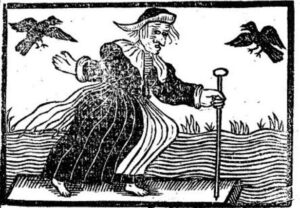 The potato lives in a “very poisonous family indeed...addictive tobacco, deadly nightshade, hallucinatory henbane, hypnotic mandrake and delirium inducing datura.” Its own poison, Solanine, can cause nightmares, hallucinations & paralysis so it seems ripe for folklore and magic.
The potato lives in a “very poisonous family indeed...addictive tobacco, deadly nightshade, hallucinatory henbane, hypnotic mandrake and delirium inducing datura.” Its own poison, Solanine, can cause nightmares, hallucinations & paralysis so it seems ripe for folklore and magic.
Old Mother Redcap, witch of the Essex marshes, might be known for taking time out from crossing rivers on hurdles to sit at her kitchen in the haunted Devil’s House peeling potatoes and singing 'Holly holly, Brolly brolly, Redcap! Bonny bonny'1 but she might have just been making lunch. Is there anything magical about the spud?
Potatoes, Faggots and Blood
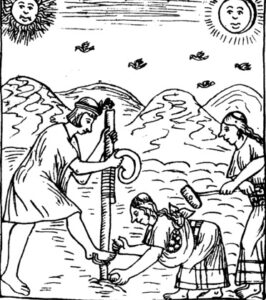 From its birthplace near lake Titicaca, centre of Incan cosmos and Tiwanaku Gateway of the Sun, to the fields of Ireland it has been subject to rituals of planting and harvest common to most crops. The modern Quechua and Aymara have an involved mythology where potatoes are planted in a green skirt of coca leaves & llama fat or dung with songs sung to the earth to suckle and support these baby girl potatoes into a virgin birth.2 While the potato seasons directly affects the music used, the instruments played and the dances danced, with new tunes from the spirits played to the potatoes growing underground.3 Modern European pagan guides mix potatoes with soap & fennel and elements of Æcerbot the old English planting ritual:4
From its birthplace near lake Titicaca, centre of Incan cosmos and Tiwanaku Gateway of the Sun, to the fields of Ireland it has been subject to rituals of planting and harvest common to most crops. The modern Quechua and Aymara have an involved mythology where potatoes are planted in a green skirt of coca leaves & llama fat or dung with songs sung to the earth to suckle and support these baby girl potatoes into a virgin birth.2 While the potato seasons directly affects the music used, the instruments played and the dances danced, with new tunes from the spirits played to the potatoes growing underground.3 Modern European pagan guides mix potatoes with soap & fennel and elements of Æcerbot the old English planting ritual:4
”Erce, Erce, Erce, earth's mother,
May the all-ruler grant you
Fields waxing, flourishing, and fertile...”
There are ritual potatoey times of the year such as the Irish round of pinning a spud and a cross to the roof at Candlemas, planting this with seed spuds on Good Friday, adding holy water sprinkling on Ascension Day, a faggot thrown in from the fires of St John’s eve and digging the potatoes up on saints days, with a potato cake used as a 12th night candle holder then also placed in the roof.5 Not hugely dissimilar to modern Peru where services, dances, parades with saint icons and burnt offerings take place in the fields in May and August.6 The moon phase often gets a look in as a must when planting (although you will have to chose between the Aymara’s waxing, de Serres’ waning or Royer’s full moonshine at Lent). It should also be only planted in the morning 7 or is that at night (in rows aligned to the North star).8 There have also been lovely children’s parades where they dance with potato sacks held high, followed by the inevitable sacrifice, with either the blood of a young and flawless llama poured over the spuds9 or the blood of a young girl who had been painted, roasted and shot with arrows.10
Toads and Potato Wolves
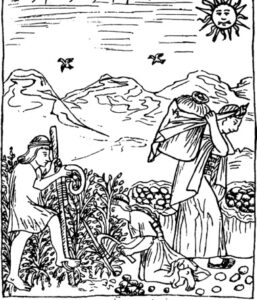 “We will kill the Potato-dog.”
“We will kill the Potato-dog.”
At harvest and planting, toads in the potato field can indicate the crops luck to the Aymara at harvest.11 A sprig of cypress was planted with the crops in Ireland and burnt with the harvest.12 In Northern Scotland all the family would have to taste newly dug potatoes otherwise “the spirits take offence and the potatoes would not keep.” While in Lithuania, when new potatoes were first eaten, all the people at the table would pull each other’s hair.13
So much for hair pulling: In parts of Northern Europe the last plant pulled catches the Potato-Wolf or Dog. A mythical beast akin to the Pea Wolf, the Oat Goat and the Hay Poodle who roam the crops and are cut down in the harvest. The harvester of the last plant (in some areas called the Old Potato Woman) takes on attributes of the wolf, biting and howling because “She has the Wolf.”14
One potato, Two Potato.. Leprosy
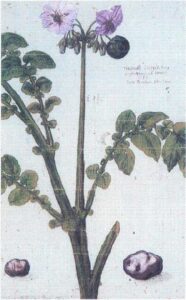 “Po - ta – toes: boil them, mash them, stick them in a stew, as a famous gardener once said”15
“Po - ta – toes: boil them, mash them, stick them in a stew, as a famous gardener once said”15
Despite being first harvested in South America at roughly the same time wheat was domesticated in Asia, able to grow in highland or jungle and forming the first freeze dried food (chuna) Europeans made some weird claims as they got to grips with this new truffley plant.
Categorised with mushrooms and strange and poisonous plants and growths16it “provoked Lust”17 (although so did a lot of plants that gave you wind or were rooty) “If too frequently eaten are thought to cause the Leprosie”18 as well as scrofula, rickets and consumption and it was blamed for weakening the blood and stopping revolution.19
Potatoes were condemned as unbiblical by Scottish Presbyterians and incestuous by Russian Orthodox (in contrast to a more positive mother/daughter potato union seen by the Aymara) The Russian Old Believers also have a delightfully horrible story where the origin of potatoes and tobacco come from a dead dog and princess killed and buried because they were lovers.20 Its similarity to Mandrake and Nightshades was noted but it was probably either its habit of shrivelling away (and taking ailments with it) or resembling a gnarly nodule which lead to its flourishing use as a magical amulet.
Pocketful of potatoes
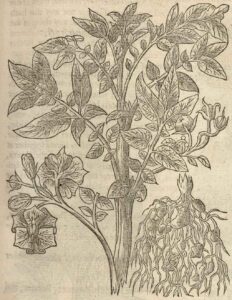 “What has it got in its pocketses?"
“What has it got in its pocketses?"
Andrew Lang wrote about a dinner table discussion of a popular Victorian belief that a potato carried around in the pocket would cure rheumatism, often with the caveat that it must be stolen (or begged), which Lang speculated was because of its similarity to Mandrake and Moly and so needing to be “acquired stealthily and with peril.”21 But the magical protection of a shrivelling spud covers more than rheumatism. A pecked potato in your pocket stops toothache22 and G. Hatfield has a whole list of pocket potato cures: back pain, cramp, chills, gallstones, piles, neuritis and nosebleeds. Whereas stuck under the bed it aids conception and stops night sweats. Not to count the endless remedies that have been applied or swallowed in desperation that are made from potato (raw, sliced, tied to your head23 or boiled in a sock), potato peel or potato water.
And on the malevolent side there are potato poppets, those with nails in24 or a spell to make your enemy waste away by putting their spit in a potato and hanging it in smoke to dry up.25 First, though, you have to collect the spit.
Spuds and Star Spit
 Tis shit from the stars, sir”26
Tis shit from the stars, sir”26
There is a type of gloop that often appears overnight which was thought to be stars fallen, splat, to earth. Morton did a number of experiments on this stuff in the 1700s and concluded it was coughed up earthworms by birds like gulls, herons and crows.27 Now days people link it to slime mould or, as Merret did in 1667, something to do with frogs.
It was also considered as the manifestation of Will of the Wisps which, like shooting stars, was thought by clever people to be just oomska rising up from the ground and falling back down again on fire to leave this slimy mess (or at least looking like fire because, as these learned folk surmised, things on fire only go up). Others, like Paracelsus, thought it was the grime and excrement of the stars in our sky. “The spittle of stars.”28
What, though, is our place amongst the stars? Is the aurora borealis just reflected bonfires? If all the North pole ice went south would it change the earth’s gravity? In 1796 Rev Playfair mused on these things and on the strange gloop seen in the fields that people said was fallen star mush. He had the answer and he wrote it down in the Statistical Survey of Scotland: it had been pecked up by birds and turned to pap by the frost but it was just the messy remains of those strange and magical potatoes.29
The bit where the Notes are longer than the post
1. Pennick refs a story told by Wentworth Day 1973 Also Gordon (2012) refs W-Day in Essex Countryside1968 and tells of Devil’s House, named such at least back to 1777, with cattle going mad, freezing temperatures, ape creatures and sound of flapping wings in empty rooms.
2. Arnold (1987). Stephenson (2012)
3. So completely linked that Bertonio (1612, II: 32) recorded the word Cahuatha to mean ‘To dance in a circle of people holding hands and ‘To pile earth up to potato plants so that they grow’ Stobart (1994) also Arnold (1987)
4. The Æcerbot is a fascinating long planting ritual full of instructions, invocations and tantalising Christian and likely pre-christian magic. Pennick (1995)
5. “On the Twelfth Night twelve candles are lighted in honour of the twelve Apostles. These candles are place in a potato cake and the potato cake is afterwards put in the roof of the house.” The Schools Collection. Also O’Sullivan and National Museum of Ireland for pinning a St Brigid cross to the roof with a stake through a spud, I have also read of a knife being used but somehow lost those notes and have spent way too long on this piece already to keep looking! Also Salaman and the Schools Collection for the other Irish planting dates and rituals (often coals and faggots from bonfires were thrown into the potato fields but there is at least one record in the SC of “sometimes they burned a potato.. in the Bonfire to improve the potato crop.”)
6. Salaman (1949)
7. According to professor Morren: “Plant the potatoes out in the morning because the potatoes planted in the afternoon take the poison with them into the soil” Munter (1846) I think he is talking about blight.
8. Pennick (1995)
9. “At about noon they began to sound drums.... On the left hand of each boy walked girls of ten years old, beautifully dressed in the same way...The girls carried bags of very fine cloth in their right hands, full of gold and silver medals. From the shoulders a lion skin hung down and covered everything... The labourers then put the ploughs on the ground, and took the bags of the large and choice potatoes, at the same time beating drums, and performing a sort of dance, raising themselves on the points of their toes, and holding up the bags which they held in their hands from time to time... They then threw the <llama> on the ground, and, having torn out the bowels... taking up as much of the <llama’s> blood as they could hold in their hands, and pouring it quickly amongst the potatoes in the bags” Cieza (1553) also Murra (1980)
10. “Her body having been painted half red and half black, she was attached to a sort of gibbet... over a fire, then shot to death with arrows... <and> was reduced to a kind of paste, which was rubbed or sprinkled...on the potatoes.. to fertilise them.” Frazer JG (1894)
Also, more bloody dip: “No... festivity is satisfactory without one or more homicides... Whenever such fights take place it is not rare to see men swallowing the brains oozing out of the fractured skulls of the wounded and women dipping chunu in the pools of blood, and eating it, when well soaked” Bandelier (1910) chuna is a sort of freeze dried potato mash which is a way of preserving potatoes and has been credited with everything from the Inca Empire to the Spanish silver trade.
11. In an oversimplification: Toads, virgins, potatoes and the moon all being linked. Black toads are the luckiest. White toads indicate white clouds & dry season, green = wet season. Arnold (1987)
12. Salaman (1949)
13. Frazer JG (1894)
14. Ibid Also Friend (1884)
15. At least in the Lord of the Rings film he does:
Sam: "Po-ta-toes! Boil them, mash them, stick them in a stew. Lovely big golden chips with a nice piece of fried fish."
Sméagol: "Phooh!"
Sam: "Even you couldn't say no to that."
Sméagol: "Oh yes we could! Spoiling nice fish! Give it to us raw and wriggling! You keep nasty chips!"
Whereas the book: “Po-ta-toes,” said Sam. “The Gaffer's delight, and rare good ballast for an empty belly. But you won't find any, so you needn't look. But be good Sméagol and fetch me some herbs, and I'll think better of you. What's more, if you turn over a new leaf, and keep it turned, I'll cook you some taters one of these days. I will: fried fish and chips served by S. Gamgee. You couldn't say no to that.”
“Yes, yes we could. Spoiling nice fish, scorching it. Give me fish now, and keep nassty chips!”
(The pocketses quote is the same in film and book)
16. Sterbeeck (1675)
17. “they encrease Seed and provoke Lust, causing Fruitfulness in both Sexes” Salmon (1710) Also seen as Lusty, a bit windy (but no worse than chestnuts) and like Mandrake by Clusius (1601) and Lusty, windy and like Belladona by Bauhin
18. Lovell (1659)
19. C19 radical Ludwig Feuerbach thought ‘potato blood’ was weakening the German people and delaying revolutions! McNeill (1999)
20. “The potato was a‘prolific, fornicating plant’.. Old Believer legend, Arkhangelsk province, 1916:‘A princess had relations with a dog. But her nannies told on her—they saw her[breast]feeding the dog. They told the ruler...and he ordered that she and the dog be buried in the earth. Potato grew from the dog, and tobacco came from her.’” Heretz, L. (2008).
21. There are a number of potatoes used for rheumatism in the wonderful Pitt Rivers Museum. Lang’s Custom and Practice (1884) seems to be erroneously dated to 1874 in some editions. The earliest date I can find for this belief is anecdotal in Notes & Queries (from 1896 despite N&Q existing since 1840s): “I have just been talking of the matter to a relative of mine, who in his younger days spent several years at sea. He tells me he remembers the superstition very well indeed, as far back as the fifties” The earliest actual written record I can easily find is Thiselton-Dyer(1881):Rheumatism.—“Professors of the healing art have advised the sufferer to carry about in his pocket the right fore-foot of a female hare, while others consider a potato equally efficacious. A Cornish cure is to crawl under a bramble which has formed a second root in the ground, or to drink water in which a thunder-stone has been boiled. There is, also, a strong belief that a galvanic ring, as it is called, worn on the finger will serve as an excellent preservative.” Altho I do wonder who his ‘professor’ is.
22. The School’s Collection. Also Friend (1884)
23. The Schools Collection
24. Report of Folklore soc. meeting in Folklore Vol 7
25. Frazer JG (1894)
26. Belcher & Swale (1984) ref Notes & Queries (ser 15) for the ‘star shit’ quote. Their excellent paper on this also mentions Paracelsus’ hot and cold stars leaving different coloured excrement, Ripley’s 1471 alchemy poem ingredient of “The slyme of stars that falleth to the ground” and they trace records of fallen stars becoming phlegm-like matter back to C12 (the fallen stars in this instance thought to be caused by strong winds forming sparks!)
27. Morton J (1712) who thought it could also be frog spawn. Also Pennant (1812). Brand’s Observations place Pennant’s note “Star Shot, or Star Gelly, owes its origin to this bird, or some of the kind being nothing but the half digested remains of earth-worms, on which these birds feed, and often discharge from their stomachs” as a Winter Gull as the note crosses into that bird’s page but Pennant seems to mean Common Gull in winter (although I guess no one else is likely to be interested in such minutiae!)
28. While we are on pointless notes: Brand’s reference to Dr Charleton’s Paradoxes viz “the nocturnal Pollution of some plethorical and wanton Star or rather excrement blown from the nostrils of some rheumatick planet falling ...like a gelly and so trembling if touched which the philosophy of the clouted shooe affirms to be the ruines of a Star fallen” is actually Helmont’s Paradoxes (1650) but Charleton added his own thoughts and notes of which this is one. Helmont’s own musings include a list of stuff dropped from the sky such as milk, blood, frogs and locusts that become solid as they descend, a white bituminous substance that turns into a kind of moss and which is sweat from celestial orbs, ‘a frothy dew’ called Aurora and ‘a more tenacious Viscid Muscilage called Sperma Siderum, the seminal emission of the stars.’
Also White T. (1656): “Ignis fatuus has been found fallen down in a slippery viscous substance full of white spots: The same, too, is the matter of Falling-starres...when any such matter is found in the Fields, the very Countrey-men cry it fell from Heav'n and the Starres, and ...call it the Spittle of the Starres. Ignes fatui (or Wills of the Wisp), then, are a certain viscous substance, reflecting light in the dark, evaporated out of a fat Earth, and flying in the Aire...Falling-Stars are a certain viscid or slimy matter, rais'd out of the Earth in very minute parts, and coagulated in the Aire; which, when, in its fall, it comes within our sight, beautifies all its way with reflected light: Yet, sometimes, it falls not downwards; but, being carry'd traversly by some motion of the Aire, 'tis call'd a Gliding star, 'till, either being dissipated, or by some other Accident, 'tis seen no more.”
29. He also sermonises against big cities and that people turning from the church would lead to a rise of the Sans Cullotes.
30. And finally, the opening section, the ‘very poisonous family’ and ‘famous gardener’ quotes are from my book Fries, it’s quite good so I hear. The above post is a lot of the stuff I read about but did not put in or even allude to – writing is funny like that.
References
Arnold D. (1987). Kinship as cosmology: potatoes as offspring among the Bolivian Aymara. The Canadian journal of native studies. 7.
Bandelier AFA (1910) The islands of Titicaca and Koati The Hispanic Soc of America
Bauhin G (1620) Prodromus Theatrici Botanici
Belcher, H., & Swale, E. (1984). Catch a Falling Star. Folklore, 95 no2
Brand J (1842) Observations on Popular Antiquities Ed H Ellis. 2nd Edtn Vol3 Charles Knight & Co
Cieza de León, Pedro de. (1553) The Travels of Pedro de Cieza de León, pt1, Tr. C. R. Markham. Hakluyt Society, 1883
Clusius C (1601) Rariorum plantarum historia
Folklore, Meeting report (1896) vol. 7, no. 4,
Frazer JG (1894) The Golden Bough Edtn 1 & 2 (1890) Macmillan
Friend H (1884) Flowers and flower lore W Swan Sonnenscheine Co
Gordon D (2012) Haunted Southend The History Press
Hatfield G (2004) Encyclopedia of Folk Medicine: Old World and New World Traditions ABC-Clio
Helmont, JB van (1650) A ternary of paradoxes Tr & Ed by W Charleton. William Lee
Heretz, L. (2008). The Old Believers: Modernization as apocalypse. Russia on the Eve of Modernity: Popular Religion and Traditional Culture under the Last Tsars (New Studies in European History) Cambridge
Lang A (1884) Custom and myth Longmans Green & Co
Lovell R (1659) Enchiridion Botanicum RIC Davis
McNeill, W H. (1999) “How the Potato Changed the World's History.” Social Research, vol. 66, no. 1
Merret C (1667) Pinax rerum naturalium britannicarum Cave Pulelyn
Morton J (1712) The Natural History of Northamptonshire Knaplock & Wilkin
Münter J (1846) Die Krankheiten der Kartoffeln Von August Hirschwald
Murra J V (1980) La organización económica del Estado inca 2nd ed. Siglo Veintiuno
Notes & Queries (Series 8) Oxford University Press
O'Sullivan J(1973) St Brigid's Crosses, Folk Life, 11:1
Pennant T (1812) British Zoology Wilkie & Robinson
Pennick N (1995) Secrets of East Anglian Magic Robert Hale ltd
Royer J: Beschreibung des gantzen Fürstlichen Braunschweigischen Gartens zu Hessem. Halberstadt, 1648.
Salaman R (1949) The History and Social Influence of the Potato Rev/Ed by JG Hawkes 1985 Cambridge UP
Salmon, WR. (1710). Botanologia, the English herbal, or, History of plants H. Rhodes.
The School’s Collection Vols 246, 481, 849 https://www.duchas.ie/en/cbes
Serres, Olivier de (1605) Le Théâtre d'agriculture et mesnage des champs, d'Olivier de Serres,... 3e édition, A. Saugrain
Sinclair J (1797) Statistical Account of Scotland. Vol 19. William Creech https://www.electricscotland.com
Stephenson A. (2012)The Quecha: Guardians of the Potato (based on interview with members of the Potato Park) Cultural Survival Quarterly 36.1
Sterbeeck F van (1675) Theatrum Fungorum
Stobart, H (1994). “Flourishing Horns and Enchanted Tubers: Music and Potatoes in Highland Bolivia.” British Journal of Ethnomusicology, vol. 3
Thiselton-Dyer Rev (1881) Domestic folk-lore
White T (1656) Peripateticall institutions. John Williams